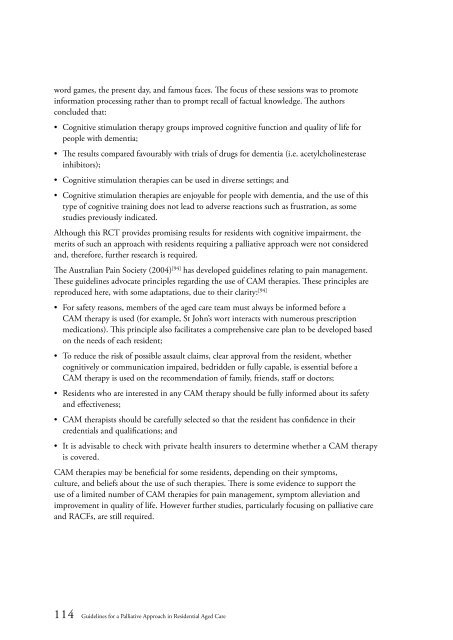Guidelines for a Palliative Approach in Residential Aged Care
Guidelines for a Palliative Approach in Residential Aged Care
Guidelines for a Palliative Approach in Residential Aged Care
Create successful ePaper yourself
Turn your PDF publications into a flip-book with our unique Google optimized e-Paper software.
word games, the present day, and famous faces. The focus of these sessions was to promote<br />
<strong>in</strong><strong>for</strong>mation process<strong>in</strong>g rather than to prompt recall of factual knowledge. The authors<br />
concluded that:<br />
• Cognitive stimulation therapy groups improved cognitive function and quality of life <strong>for</strong><br />
people with dementia;<br />
• The results compared favourably with trials of drugs <strong>for</strong> dementia (i.e. acetylchol<strong>in</strong>esterase<br />
<strong>in</strong>hibitors);<br />
• Cognitive stimulation therapies can be used <strong>in</strong> diverse sett<strong>in</strong>gs; and<br />
• Cognitive stimulation therapies are enjoyable <strong>for</strong> people with dementia, and the use of this<br />
type of cognitive tra<strong>in</strong><strong>in</strong>g does not lead to adverse reactions such as frustration, as some<br />
studies previously <strong>in</strong>dicated.<br />
Although this RCT provides promis<strong>in</strong>g results <strong>for</strong> residents with cognitive impairment, the<br />
merits of such an approach with residents requir<strong>in</strong>g a palliative approach were not considered<br />
and, there<strong>for</strong>e, further research is required.<br />
The Australian Pa<strong>in</strong> Society (2004) [94] has developed guidel<strong>in</strong>es relat<strong>in</strong>g to pa<strong>in</strong> management.<br />
These guidel<strong>in</strong>es advocate pr<strong>in</strong>ciples regard<strong>in</strong>g the use of CAM therapies. These pr<strong>in</strong>ciples are<br />
reproduced here, with some adaptations, due to their clarity: [94]<br />
• For safety reasons, members of the aged care team must always be <strong>in</strong><strong>for</strong>med be<strong>for</strong>e a<br />
CAM therapy is used (<strong>for</strong> example, St John’s wort <strong>in</strong>teracts with numerous prescription<br />
medications). This pr<strong>in</strong>ciple also facilitates a comprehensive care plan to be developed based<br />
on the needs of each resident;<br />
• To reduce the risk of possible assault claims, clear approval from the resident, whether<br />
cognitively or communication impaired, bedridden or fully capable, is essential be<strong>for</strong>e a<br />
CAM therapy is used on the recommendation of family, friends, staff or doctors;<br />
• Residents who are <strong>in</strong>terested <strong>in</strong> any CAM therapy should be fully <strong>in</strong><strong>for</strong>med about its safety<br />
and effectiveness;<br />
• CAM therapists should be carefully selected so that the resident has confidence <strong>in</strong> their<br />
credentials and qualifications; and<br />
• It is advisable to check with private health <strong>in</strong>surers to determ<strong>in</strong>e whether a CAM therapy<br />
is covered.<br />
CAM therapies may be beneficial <strong>for</strong> some residents, depend<strong>in</strong>g on their symptoms,<br />
culture, and beliefs about the use of such therapies. There is some evidence to support the<br />
use of a limited number of CAM therapies <strong>for</strong> pa<strong>in</strong> management, symptom alleviation and<br />
improvement <strong>in</strong> quality of life. However further studies, particularly focus<strong>in</strong>g on palliative care<br />
and RACFs, are still required.<br />
114 <strong>Guidel<strong>in</strong>es</strong> <strong>for</strong> a <strong>Palliative</strong> <strong>Approach</strong> <strong>in</strong> <strong>Residential</strong> <strong>Aged</strong> <strong>Care</strong>
















